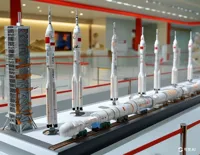







Thirty years, a mere blink in the vast history of the universe, marks an epic journey for China's Manned Space Program. Since its inception in 1992, this program has been like a brave explorer, cutting through technological thickets to reach the stars and beyond.
The story begins in 1992 when the Manned Space Program was officially launched under the codename "Project 921". This ambitious plan aimed to send Chinese astronauts into space to explore the cosmos. In 1999, the successful launch of the Shenzhou I unmanned test spacecraft marked the official start of China's Manned Space Program. This was not just a technological leap but a significant breakthrough in the history of Chinese spaceflight.
In 2003, the Shenzhou V spacecraft, carrying Yang Liwei, successfully blasted off into space, making China the third country in the world to independently send humans into space. At that moment, the world heard China's voice and saw its strength. Yang Liwei's space journey was not only a personal honor but also the realization of a national dream.
Subsequently, the pace of China's Manned Space Program accelerated. In 2005, the Shenzhou VI mission achieved multiple astronauts' multi-day spaceflight; in 2008, the Shenzhou VII mission completed the first spacewalk by Chinese astronauts. Each flight was an innovation in technology, and each success was a challenge to human limits.
In 2011, the successful launch of the Tiangong-1 space lab marked the prelude to the construction of China's space station. In 2013, the Shenzhou X mission successfully docked with Tiangong-1, making China the third country to master space rendezvous and docking technology. This was not only a technological breakthrough but also a display of China's space capabilities.
Entering the third decade of the 21st century, China's Manned Space Program has experienced explosive development. In 2021, the Shenzhou XII mission successfully launched, with Chinese astronauts entering their own space station— the Tianhe core module—for the first time. This was an important milestone in the construction of China's space station and a new starting point for China's Manned Space Program.
Over the past thirty years, China's Manned Space Program has achieved world-renowned accomplishments. From Shenzhou I to Shenzhou XII, from unmanned tests to manned flights, from spacewalks to space station construction, each step has been a testament to the sweat and wisdom of Chinese space professionals, and each success has carried the hopes and dreams of the Chinese nation.
Looking to the future, China's Manned Space Program will continue to forge ahead. We look forward to more astronauts entering space, more scientific experiments conducted on the space station, and more technological challenges overcome. China's Manned Space Program is not only a source of pride for China but also a beacon of hope for humanity's exploration of the cosmos.